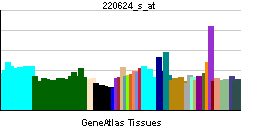ELF5
| E74-like factor 5 (ets domain transcription factor) | |||||||||||||
|---|---|---|---|---|---|---|---|---|---|---|---|---|---|
 PDB rendering based on 1wwx. | |||||||||||||
| |||||||||||||
| Identifiers | |||||||||||||
| Symbols | ELF5 ; ESE2 | ||||||||||||
| External IDs | Template:OMIM5 Template:MGI HomoloGene: 7702 | ||||||||||||
| |||||||||||||
| RNA expression pattern | |||||||||||||
 | |||||||||||||
 | |||||||||||||
| More reference expression data | |||||||||||||
| Orthologs | |||||||||||||
| Template:GNF Ortholog box | |||||||||||||
| Species | Human | Mouse | |||||||||||
| Entrez | n/a | n/a | |||||||||||
| Ensembl | n/a | n/a | |||||||||||
| UniProt | n/a | n/a | |||||||||||
| RefSeq (mRNA) | n/a | n/a | |||||||||||
| RefSeq (protein) | n/a | n/a | |||||||||||
| Location (UCSC) | n/a | n/a | |||||||||||
| PubMed search | n/a | n/a | |||||||||||
E74-like factor 5 (ets domain transcription factor), is a gene found in both mice and humans.[1] In humans it is also called ESE2.
The protein encoded by this gene is a member of an epithelium-specific subclass of the Ets transcritpion factor family. In addition to its role in regulating the later stages of terminal differentiation of keratinocytes, it appears to regulate a number of epithelium-specific genes found in tissues containing glandular epithelium such as salivary gland and prostate. It has very low affinity to DNA due to its negative regulatory domain at the amino terminus. Two alternatively spliced transcript variants encoding different isoforms have been described for this gene.[1]
References
Further reading
- Sharrocks AD, Brown AL, Ling Y, Yates PR (1998). "The ETS-domain transcription factor family". Int. J. Biochem. Cell Biol. 29 (12): 1371–87. PMID 9570133.
- Zhou J, Ng AY, Tymms MJ; et al. (1998). "A novel transcription factor, ELF5, belongs to the ELF subfamily of ETS genes and maps to human chromosome 11p13-15, a region subject to LOH and rearrangement in human carcinoma cell lines". Oncogene. 17 (21): 2719–32. doi:10.1038/sj.onc.1202198. PMID 9840936.
- Oettgen P, Kas K, Dube A; et al. (1999). "Characterization of ESE-2, a novel ESE-1-related Ets transcription factor that is restricted to glandular epithelium and differentiated keratinocytes". J. Biol. Chem. 274 (41): 29439–52. PMID 10506207.
- Strausberg RL, Feingold EA, Grouse LH; et al. (2003). "Generation and initial analysis of more than 15,000 full-length human and mouse cDNA sequences". Proc. Natl. Acad. Sci. U.S.A. 99 (26): 16899–903. doi:10.1073/pnas.242603899. PMID 12477932.
- Ota T, Suzuki Y, Nishikawa T; et al. (2004). "Complete sequencing and characterization of 21,243 full-length human cDNAs". Nat. Genet. 36 (1): 40–5. doi:10.1038/ng1285. PMID 14702039.
- Gerhard DS, Wagner L, Feingold EA; et al. (2004). "The status, quality, and expansion of the NIH full-length cDNA project: the Mammalian Gene Collection (MGC)". Genome Res. 14 (10B): 2121–7. doi:10.1101/gr.2596504. PMID 15489334.
- Lapinskas EJ, Palmer J, Ricardo S; et al. (2005). "A major site of expression of the ets transcription factor Elf5 is epithelia of exocrine glands". Histochem. Cell Biol. 122 (6): 521–6. doi:10.1007/s00418-004-0713-x. PMID 15655699.
- Yaniw D, Hu J (2005). "Epithelium-specific ets transcription factor 2 upregulates cytokeratin 18 expression in pulmonary epithelial cells through an interaction with cytokeratin 18 intron 1". Cell Res. 15 (6): 423–9. doi:10.1038/sj.cr.7290310. PMID 15987600.
- Rual JF, Venkatesan K, Hao T; et al. (2005). "Towards a proteome-scale map of the human protein-protein interaction network". Nature. 437 (7062): 1173–8. doi:10.1038/nature04209. PMID 16189514.
- Tummala R, Sinha S (2006). "Differentiation-specific transcriptional regulation of the ESE-2 gene by a novel keratinocyte-restricted factor". J. Cell. Biochem. 97 (4): 766–81. doi:10.1002/jcb.20685. PMID 16229011.
- Taylor TD, Noguchi H, Totoki Y; et al. (2006). "Human chromosome 11 DNA sequence and analysis including novel gene identification". Nature. 440 (7083): 497–500. doi:10.1038/nature04632. PMID 16554811.
- Choi YS, Sinha S (2006). "Determination of the consensus DNA-binding sequence and a transcriptional activation domain for ESE-2". Biochem. J. 398 (3): 497–507. doi:10.1042/BJ20060375. PMID 16704374.
- Lim J, Hao T, Shaw C; et al. (2006). "A protein-protein interaction network for human inherited ataxias and disorders of Purkinje cell degeneration". Cell. 125 (4): 801–14. doi:10.1016/j.cell.2006.03.032. PMID 16713569.
External links
- ELF5+protein,+human at the US National Library of Medicine Medical Subject Headings (MeSH)
| This protein-related article is a stub. You can help Wikipedia by expanding it. |
This article incorporates text from the United States National Library of Medicine, which is in the public domain.